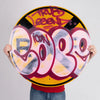
Graffiti Art Street Signs: Unconventional Investment Grade Art
, by Bobby Banks, 5 min reading time

, by Bobby Banks, 5 min reading time
In recent years, graffiti street art has gained significant recognition and value in the world of contemporary art. As with any investment, a savvy collector looks for a unique niche with potential to appreciate over time. One such niche in the street art world is graffiti on street signs. This article delves into the history of graffiti street art on street signs, its cultural significance, and why it has become an attractive option for investment-grade art. Graffiti street art has been around for centuries, with early examples dating back to ancient Rome and Greece. However, it was not until the 20th century that this art form gained prominence as a countercultural movement. The 1960s and '70s saw the birth of modern graffiti in New York City, where artists began tagging subway cars and walls with their unique signatures. Over time, graffiti artists looked for new canvases to make their mark, and street signs emerged as one such medium. This unconventional choice allowed artists to merge their work with the urban landscape and create a unique form of public art. Moreover, street signs provided a sense of permanence, as they were unlikely to be removed or painted over.
Graffiti on street signs is more than just an artistic statement – it is also an act of rebellion and a means of reclaiming public spaces. Artists have used this medium to express their social and political views, as well as to challenge the status quo. By altering street signs, graffiti artists transform mundane objects into eye-catching works of art that can inspire conversation and reflection. This act of repurposing and recontextualizing street signs is a powerful tool that draws attention to issues of public space ownership, gentrification, and the role of art in society.
Graffiti on street signs has been embraced by various artists, each bringing their unique style and message to the medium. Some noteworthy artists and examples include:
Clet Abraham: A French street artist, Clet is known for his clever manipulation of street signs, using minimalist stickers to transform their original meaning. His works often evoke humor and provoke thought, challenging viewers to question authority and societal norms.
Vhils: Portuguese artist Alexandre Farto, better known as Vhils, is renowned for his 'Scratching the Surface' technique, where he carves images into the surfaces of street signs and walls. Vhils' work explores themes of urban decay and regeneration, often featuring portraits of local residents.
Roadsworth: Canadian artist Peter Gibson, aka Roadsworth, uses street signs and road markings as the basis for his intricate stencil work. His art addresses environmental and political issues, promoting sustainability and questioning consumer culture.
The growing recognition and appreciation of graffiti street art have led to a surge in demand for these unique works. As with any art investment, the value of graffiti on street signs depends on several factors, including the artist's reputation, the artwork's rarity, and the prevailing market conditions. Here are some reasons why graffiti street art on street signs has become an attractive option for investment-grade art:
Authenticity and Rarity: As public art, graffiti on street signs is often produced in limited quantities. Each piece is unique and impossible to replicate, making it highly sought after by collectors. Moreover, the inherent risk involved in creating such artworks adds to their allure and authenticity.
Historical and Cultural Significance: Street art has become an essential part of urban culture, with many cities embracing it as a vital element of their identity. Graffiti on street signs captures a moment in time and offers a glimpse into the social, political, and cultural issues of that period. As such, these works can become valuable historical artifacts that appreciate over time.
Growing Recognition and Market Demand: The street art market has experienced significant growth in recent years, with major auction houses and galleries now showcasing graffiti artists. This increased visibility has led to a surge in demand for unique works, including graffiti on street signs.
Potential for Capital Appreciation: As the market for street art continues to grow, so too does the potential for capital appreciation. With a limited supply of genuine graffiti on street signs, collectors who invest early in these works can benefit from the rising demand and the potential for substantial returns on their investment.
Diversification of Art Portfolio: Investing in graffiti street art on street signs offers an opportunity to diversify one's art portfolio. This niche market can provide a unique investment that complements more traditional art forms, such as paintings and sculptures.
Graffiti street art on street signs is an unconventional yet increasingly popular form of investment-grade art. Its unique blend of cultural significance, rarity, and growing market demand makes it an attractive option for collectors looking to diversify their art portfolio and capitalize on the burgeoning street art scene. As with any investment, it is essential to conduct thorough research and consult with experts before venturing into this niche market. However, for those willing to take the risk, graffiti street art on street signs can offer both aesthetic and financial rewards.